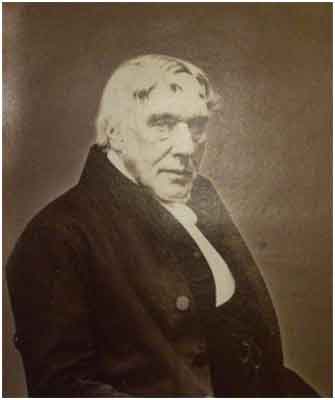1840 - 1860
 Richard Alexander
Richard AlexanderSelf-Portrait
Albumen print [cropped], circa 1860
 Richard Alexander
(1788-1865)
Richard Alexander
(1788-1865)
Banker, Philanthropist, Botanist and
Member of
the Photographic Society.
Richard Dykes Alexander, a wealthy Ipswich banker, was related by marriage to the banking families Gurney of Norfolk and Peckover of Wisbech. His obituary, published in the Suffolk Chronicle 1, said of him ‘…a highly useful & respected townsman, whose long life was for the most part spent in doing good…’ He was a Quaker who devoted much of his life to the Society of Friends, Anti-Slavery Society, Bible Society, Peace Society and the Temperance Movement. He funded and built the Temperance Hall in Ipswich, the East Suffolk Hospital and founded the Ipswich Ragged School. When the Wisbech and Fenland Museum opened in 1835 Richard made a donation2 of‘four folio volumes containing a series of British plants’ and 243 specimens of plants.
There seems to be no record of when he first started making photographs but he did have family connections3 with Henry Talbot, who invented the negative–positive process. Most of his photographs, together with his photographic equipment, were sold at Sotheby’s Belgravia in 1978. Several of the lots are now deposited with the Suffolk Record Office and embrace two albums of fine photographs, one of portraits and one of landscapes together with stereographs and paper negatives. The printed photographs date from 1853 but the paper negatives may have been made before then. He became a member of the Photographic Society in 1853 and he showed4 eight lots of photographs printed from collodion negatives at their 1858 exhibition held at the South Kensington Museum.
The Gallery shows reproductions of stereographs taken by Alexander in Norfolk and are by courtesy of the Suffolk Record Office. These stereographs and other medium-format prints date from around 1860.
Sources and Notes
- Suffolk Chronicle, December 23, 1865.
- Nelson, E.C. 2003. Wisbech and Fenland Museum herbarium (WBCH): a history with a list of collectors. Watsonia 24, 489-498.
- Taylor, Roger. Impressed by Light. British Photographs from Paper Negatives, 1840-1860. New York: The Metropolitan Museum Of Art, 2007. Richard’s nephew was a photographic pioneer John Dyllwin Llewelyn (1810-1882) who married Emma Talbot, a cousin of Henry Talbot who invented the negative-positive photograph process.
- Taylor, Roger. Photographs Exhibited in Britain 1839-1865. Ottawa: National Galley of Canada, 2002.